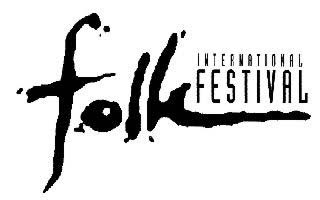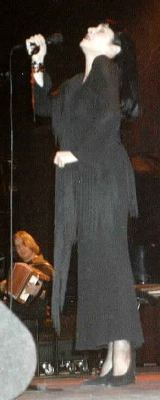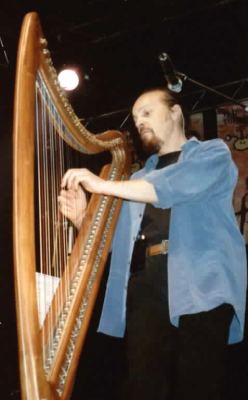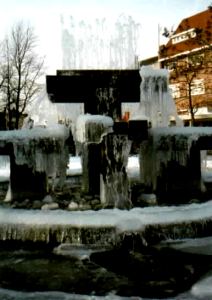
FolkWorld Live Review 4/2001: Tilburg festival review No. 3

Having heard much praise about Tilburg's International Folk Festival from the editors last year, five of us Folkworld writers travelled to Tilburg this January to find out what it was really like. And yes, it's every bit as good as we had been told - the weather was seriously wintry, but since the festival has some fine indoor venues to use, especially the purpose-built music venue 013 Popcentrum, it didn't matter much.
 Friday evening at the Popcentrum was devoted to Portuguese music, starting with Frei Fado d'el Rei, who played a nice mix of Portuguese music which didn't seem to include much fado. Next were Gaiteros de Lisboa - another misnomer, since they played all sorts of instruments but very little gaita; lots of different drums were prevalent instead. They were seriously weird, quite an experience but perhaps not one I'd want to repeat.
Friday evening at the Popcentrum was devoted to Portuguese music, starting with Frei Fado d'el Rei, who played a nice mix of Portuguese music which didn't seem to include much fado. Next were Gaiteros de Lisboa - another misnomer, since they played all sorts of instruments but very little gaita; lots of different drums were prevalent instead. They were seriously weird, quite an experience but perhaps not one I'd want to repeat.
While the great hall was being prepared for fado star Misia, the small auditorium had a concert by "Danças Ocultas". Neither the name nor the description (an accordion quartet made up of music students) sounded too promising, but we thought we'd have a look anyway - and stumbled onto the highlight of the entire evening. The four accordionists play some amazing ensemble music (self-composed) in which the instruments seem to hold conversations with each other and produce some astonishing sounds in the process. I'd never heard an accordionist use the air button as part of a tune before! Yet the music is pleasant to listen to and very accessible. Finally Misia rounded of an enjoyable and varied evening of Portuguese music with a professional performance in the large auditorium, accompanied by a small band.
 Like last year, the weekend concerts at the Popcentrum were themed concerts, under the headings "The Celtic Connection" on Saturday and "New Folk Adventure" on Sunday. "Celtic" is used liberally in Tilburg, and in this case included Alain Stivell from Britanny and Xosé Manuel Budiño from Galicia among the performers. The evening's opening act was Irish, however. And in amongst all the exotic sounds and "new Celtic" music staged at the festival, it was great to see a really good traditional Irish all-instrumental group. Danú managed to convince with an exuberant and impressive performance which needed no technical wizardry.
Like last year, the weekend concerts at the Popcentrum were themed concerts, under the headings "The Celtic Connection" on Saturday and "New Folk Adventure" on Sunday. "Celtic" is used liberally in Tilburg, and in this case included Alain Stivell from Britanny and Xosé Manuel Budiño from Galicia among the performers. The evening's opening act was Irish, however. And in amongst all the exotic sounds and "new Celtic" music staged at the festival, it was great to see a really good traditional Irish all-instrumental group. Danú managed to convince with an exuberant and impressive performance which needed no technical wizardry.
By contrast, Sunday's first performer, the Finnish accordionist Kimmo Pohjonen went a lot further than simply using modern technology to enhance his stage performance, exploiting it to create something that is very far from any folk music which he may occasionally use as a starting point. His performance was a total aural experience rather than a playing of music in the usual sense, using speakers at all four corners of the room to immerse the listener in an amazing soundscape of computerised effects and sounds triggered by the accordion on the stage and processed through the sound engineer's computer equipment.
 Kimmo Pohjonen opened a long and diverse day of music, which went on to include the huge "Hungarian hurdy gurdy and bagpipe orchestra" (about ten bagpipes and ten hurdy gurdys plus four fiddles, three female singers and percussion, playing traditional Hungarian music in assorted combinations - drone overkill, but wonderful!), a brass ensemble called Compánia Electrica Dharma who sounded like a Spanish version of the Bollywood Brass Band (I think they even covered one of their tunes!), Asturian shooting star bagpiper Hevia and much more.
Kimmo Pohjonen opened a long and diverse day of music, which went on to include the huge "Hungarian hurdy gurdy and bagpipe orchestra" (about ten bagpipes and ten hurdy gurdys plus four fiddles, three female singers and percussion, playing traditional Hungarian music in assorted combinations - drone overkill, but wonderful!), a brass ensemble called Compánia Electrica Dharma who sounded like a Spanish version of the Bollywood Brass Band (I think they even covered one of their tunes!), Asturian shooting star bagpiper Hevia and much more.
In between these concerts in the large auditorium, the smaller one featured a couple of Dutch bands (the first one of which, Cadans der Getouwen, had some trouble fitting all of their players onto the small stage!) and English trio (Chris) Wood, (Roger) Wilson, (Martin) Carthy, who sounded a bit under-rehearsed. Being unimpressed by them, I walked off to discover an even smaller room, the tiny BatCave, which had an informal session-cum-concert by local group Pendel, who played a mix of Balkan and ancient Dutch music, half instrumental, half sung by a handsome blonde female singer with a great voice. A group to look out for!
To sum up, Tilburg International Folk Festival is well worth a visit - it offers a diverse range of music from traditional to avant-garde, a good mix of superstar performers and relative unknowns, and it is very well organised. The free and readily available festival brochure is a nicely designed, handy guide to proceedings (at least if you understand rudimentary Dutch), a well-working, simple voucher system means catering is quick and efficient, people are friendly and hospitable and communication (in English) is surprisingly easy. A big compliment to the organisers - let's hope it will continue for many more years!
There is another review of the Tilburg International Folk Festival in this issue: Review .
Photo Credit: Photos by Anja Beinroth, all taken at Tilburg International Folk Festival 2001:
(1) Misia, (2) Alain Stivell, (3) Tilburg in January
Further infos available at: Homepage of Tilburg International Folk Festival
To the content of FolkWorld Articles, Live Reviews & Columns
To the content of FolkWorld online magazine Nr. 18
All material published in FolkWorld is © The Author via FolkWorld. Storage for private use is allowed and welcome. Reviews and extracts of up to 200 words may be freely quoted and reproduced, if source and author are acknowledged. For any other reproduction please ask the Editors for permission.
